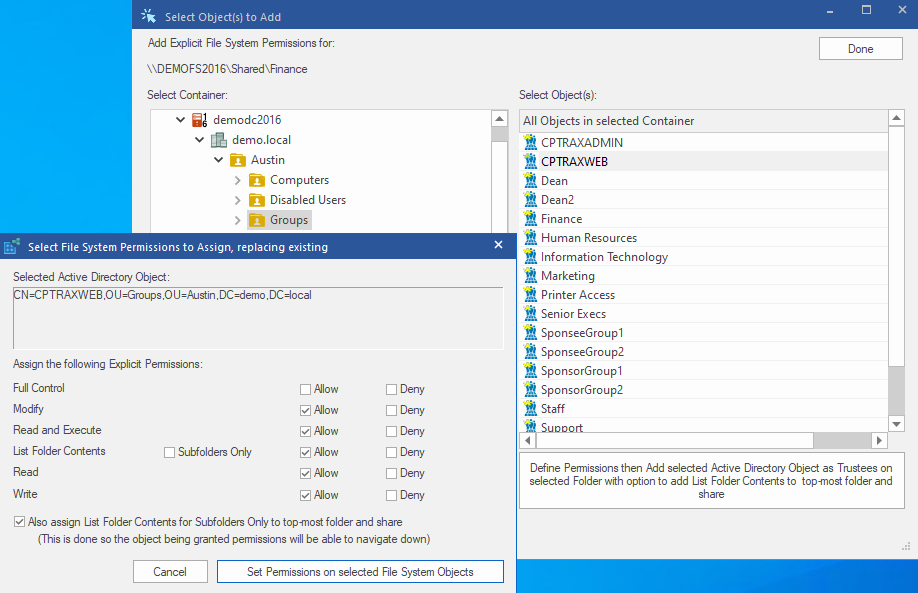

GetAccessControl() method on the FileInfo and DirectoryInfo classes: FileInfo info = new fs = info.GetAccessControl() ĭirectoryInfo dir = new ds = dir. check all site-level and list-level roles and privileges. Permissions for files and directories can e.g.
List of active directory permissions windows#
When you have an AD group or user account, you can read it's SID (Security Identifier) property - that SID will show up in ACL's (Access Control Lists) all over Windows - but from the user or group, there's no mechanism to get all permissions it might have anywhere in the machine/server. files and/or directories - or other objects (like registry keys, etc.). Permissions are stored on the individual file system items, e.g.

Those aren't stored in Active Directory - and therefore, you can't retrieve those from any AD code. The new S.DS.AM makes it really easy to play around with users and groups in AD! do whatever you need to do to those members GroupPrincipal group = GroupPrincipal.FindByIdentity(ctx, "YourGroupNameHere") įoreach (Principal p in group.GetMembers())Ĭonsole.WriteLine("", p.StructuralObjectClass, p.DisplayName) UserPrincipal user = UserPrincipal.FindByIdentity(ctx, "SomeUserName") PrincipalContext ctx = new PrincipalContext(ContextType.Domain) MSDN docs on īasically, you can define a domain context and easily find users and/or groups in AD: // set up domain context.Managing Directory Security Principals in the.NET 3.5 and up, you should check out the (S.DS.AM) namespace. After a user with role "super admin" has been synchronized for the first time he is added to the admin user list in WordPress Multisite.If you're on.You will see an error message if you try to assign the role inside a site configuration. Because of security reasons the role super admin can only be assigned in a profile configuration and not in site configuration.As mentioned, the role super admin can only be assigned inside a Multisite environment.A Super Admin has access to the Multisite network administration and can do everything. WordPress has a special role called "super admin" which is only available in Multisite environment. If this option is enabled, it will remove all previous assigned WordPress roles while updating the user and assigning the roles configured in "Role equivalent groups". If you imported users from primary groups for example "Domain Users" via "id:513", you still have to enter the group name here. Then he belongs to the WordPress roles editor and author. If the user belongs to the security groups Sales_SEC and Financial_SEC and the "Role equivalent group" contains the following configuration Sales_SEC = editor allowed) on an Active Directory object, in light of accurately considering the collective impact of all the security permissions specified in the access control list (ACL) of that Active Directory object. If an Active Directory user is member of multiple security groups and all of them are mapped to WordPress roles, the roles are accumulated. Active Directory Effective Permissions are the actual (resulting) set of permissions that a user is actually granted (i.e. Any Role equivalent group for B-1 will not be assigned.Įxamples for this option ad-group = wp-role Because of this he is a member of A-1 but not B-1. During the login only the first authenticated domain is used. The user who wants to login is member of both domains. A has a security group named A-1 and B has a security group named B-1. Let's suppose you have two domains A and B. Please note that group memberships cannot be checked across multiple domains: Every mapping has to be defined in its own row.Ī whole list of WordPress' Roles and Capabilities can be found at: (3.8 Capability vs. Role equivalent groupsĮnter the names of the Active Directory security groups which correspond to WordPress' roles. Only users being member of one of the configured Active Directory security groups can log into the WordPress instance. If you have enabled Authorize by group membership you must provide the names of the Active Directory security groups which should have access to the WordPress instance. The roles of the user are still defined by the Role equivalent groups. If you disable this option every Active Directory user below the Base DN can log in. The authorization occurs after the authentication. This option authorizes only members of the given Active Directory security groups to gain access to WordPress. Permissions Authorize by group membership With the Permission page you can restrict which users of your Active Directory users are allowed to login. Connecting NADI to Synology Directory Server.
List of active directory permissions how to#


 0 kommentar(er)
0 kommentar(er)
